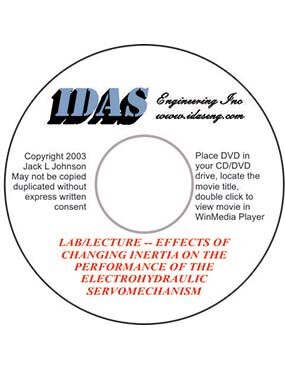
Four Methods for Dealing with the Difficult Electrohydraulic System DVD
This DVD has 2 video training sessions plus a complete printable transcript of the voice-over audio. The Difficult System is one in which the electrohydraulic motion control system starts and stops with a springiness that can’t be adequately suppressed with the amplifier gain or with PID controller adjustments. The problem is normally associated with a cylinder with a bore that is too small for the mass/inertia load that it has to propel. The result is that the hydromechanical resonant frequency is too low. Too often a larger cylinder is deemed to be too expensive and the control systems engineer has to make do with the system at hand. This video shows the problems in a lab set up, and then implements the corrective actions, four of them, and you can see for yourself the degree of improvement in system response. The lab demonstration is supported by a video lecture that explains the engineering principles that are being applied in the lab. This is a must for the engineer who has had to grapple with such problems, and the insights that are demonstrated are worth far more than the modest cost of the video. There is also a “Learning Exam” which challenges even the most seasoned motion control engineer.
$79.00
Visit our Ebay Electrohydraulic Book Store to browse
or shop or purchase. No obligation to buy. CLICK HERE.

Effects of Changing Inertia on the Performance of the Electrohydraulic Servo
When automating the motion control of a hydraulic system, the challenges often come as a result of having too much inertia in the load and a cylinder that is actuated with too small a piston area. The result is a low resonant frequency caused by the interaction of the energy stored in the fluid compressibility, behaving as a spring, being cyclically exchanged with the momentum energy in the massive load. The result is the low resonant frequency of the system and a springy motion and difficulty in controlling the motion, especially with electronic feedback controls implemented (servomechanism). Far too often hydraulic cylinders are sized based upon the assumption of a static load, like the dead weight being lifted by an end loader, and made worse by electronic controls engineers who do not understand hydraulic system dynamic reactions. Making it worse yet is the drive to reduce component size and weight by increasing pressure. This makes the challenges even more severe. The lab video demonstrates how a smartly acting servo system responds well to input commands, but then progressively degrades as more and more inertia is added. The video offers you a chance to see the effects as they are occurring. In the end, the system is so over whelmed by the inertia that it is impossible to control except by slowing down the motion and reducing productivity. A video lecture is included that explains the principles and challenges involved.
$79.00
Visit our Ebay Electrohydraulic Book Store to browse
or shop or purchase. No obligation to buy. CLICK HERE.
Note: eBay is a registered trademark of eBay incorporated